Aluminum Fabrication Services
Upload your CAD files to get an instant online aluminum fabrication quote on custom prototypes and production parts. Lead times as fast as days and free standard shipping on all US orders.
Aluminum is the most common non-ferrous metal on the market and is praised for its low density, high strength-to-weight ratio, durability, natural corrosion resistance, thermal properties, and more. Xometry offers high-quality aluminum fabrication services for multiple industries — from automotive and aerospace to construction and electronics. Our aluminum fabrication services include: custom aluminum fabrication, CNC machining, sheet metal fabrication, precision laser cutting, finishing, and more. Our industry experience and deep understanding of manufacturing processes ensure that aluminum parts are made to customers’ specific requirements. Couple that with our vast manufacturing network and you can rest assured that your aluminum parts will meet both your schedule and the highest standards of quality.
Aluminum 5052
This aluminum alloy uses magnesium as its primary alloying element. It has excellent corrosion resistance due to the lack of copper in its composition. Though 5052 cannot be heat treated, it has the highest strength of the non-heatable alloys. This alloy also has better formability than series 3 alloys. It is typically used for fuel tanks and highway and road signs.
| Material | Standard Sheet Thicknesses |
|---|---|
Material Aluminum 5052 H32 | Standard Sheet Thicknesses 0.020”, 0.025”, 0.032”, 0.040”,0.050”, 0.063”, 0.080”, 0.090”, 0.100”, 0.125”, 0.160”, 0.188”, 0.250”, 0.375”, 0.500” |
| Tensile Strength, Yield (MPa) | Shear Modulus (GPa) | Elongation at Break (%) | Hardness (Brinell) | Density (g/cm^3) |
|---|---|---|---|---|
Tensile Strength, Yield (MPa) 193 | Shear Modulus (GPa) 117 | Elongation at Break (%) 18 | Hardness (Brinell) 60 | Density (g/cm^3) 2.68 |
Aluminum 6061
This is among the most “general-purpose” aluminum alloys. The primary alloying elements are magnesium and silicon and it will accept heat treatment. Bending aluminum 6061 is not recommended after it reaches high tempering levels because at that point it is likely to crack. This aluminum alloy can be used for sheet metal parts but requires some care and preparation.
| Material | Standard Sheet Thicknesses |
|---|---|
Material Aluminum 6061 T6 | Standard Sheet Thicknesses 0.016”, 0.020”, 0.025”, 0.032”, 0.040”, 0.050”, 0.063”, 0.080”, 0.090”, 0.100”, 0.125”, 0.160”, 0.190”, 0.250”, 0.313”, 0.375”, 0.500”, 0.625”, 0.750”, 0.750”, 0.875”, 1.000” |
| Tensile Strength, Yield (MPa) | Shear Modulus (GPa) | Elongation at Break (%) | Hardness (Brinell) | Density (g/cm^3) |
|---|---|---|---|---|
Tensile Strength, Yield (MPa) 276 | Shear Modulus (GPa) 96.5 | Elongation at Break (%) 17 | Hardness (Brinell) 95 | Density (g/cm^3) 2.7 |
Aluminum Fabrication Process
The aluminum fabrication process requires careful and meticulous planning to ensure products are made to exact customer specifications with no delays. At Xometry, our first step is to review the client’s design and determine the best manufacturing methods and process flow for the project. At this stage, Xometry collaborates with the client to ensure the critical design features are captured and achievable using aluminum fabrication techniques like CNC machining, sheet metal forming, die casting, laser cutting, plasma cutting, and more. The product’s features, requirements, geometry, and volume will determine which fabrication method is best.
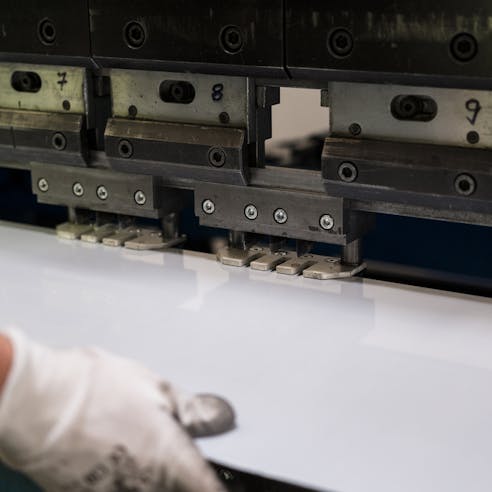
Advantages of Aluminum Fabrication
Aluminum has many desirable properties that make it ideal for numerous industries. Listed below are a few advantages of aluminum:
- Lightweight Nature
- Corrosion Resistance
- High Strength-to-Weight Ratio
- Recyclability
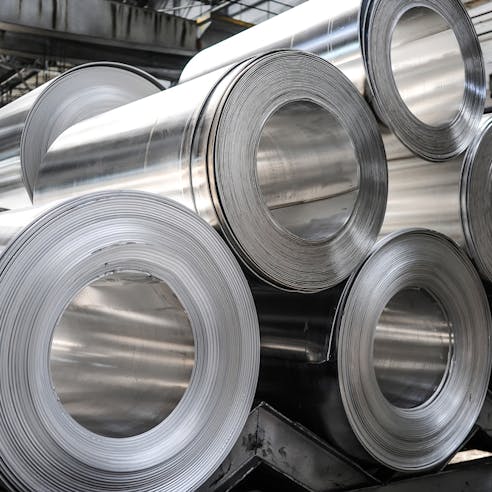
Lightweight Nature
Aluminum has a density of 2.71 g/cm3, about one-third the density of steel. This makes aluminum cheaper, less massive, and easier to transport. Additionally, its minimal weight makes it great for places like the aerospace or automotive industries where mass is a limiting factor.
Corrosion Resistance
Aluminum naturally resists corrosion by generating a protective oxide layer on its surface. Aluminum is very reactive to oxygen. Therefore when it contacts air, a thin oxide layer about 4-5 nm thick forms on the part. Unlike iron, which oxidizes into rust, aluminum’s oxide layer protects the surface from corrosion. While aluminum is naturally resilient, surface treatments like painting or anodizing can further improve the metal’s corrosion resistance. Aluminum’s properties make it an excellent choice for applications in corrosion-inducing environments.
High Strength-to-Weight Ratio
Aluminum has a high strength-to-weight ratio, so it fits in well wherever weight is a major concern. Aircraft and automobiles make heavy use of aluminum for that reason. Aluminum has a density of 2.71 g/cm3, but its yield strength varies between 24-483 MPa, depending on the type of aluminum alloy. In comparison, steel is almost three times denser at 7.8 g/cm3. While steel is stronger (yield strength between 220-1570 MPa), its weight makes it untenable for lightweight construction. Aluminum shines when it comes to applications that require low weight and load-bearing capability.
Recyclability
Aluminum is highly recyclable; none of the metal is lost in the recycling process. Manufacturers can thus reduce their environmental impact and carbon footprint while also minimizing costs. Some purchase recycled aluminum for manufacturing, recycle aluminum for internal use, or sell scrap aluminum.
Disadvantages of Aluminum Fabrication
Aluminum also has disadvantages as listed below:
- Lower Melting Point
- Susceptibility to Galvanic Corrosion
- Higher Cost Than Other Metals
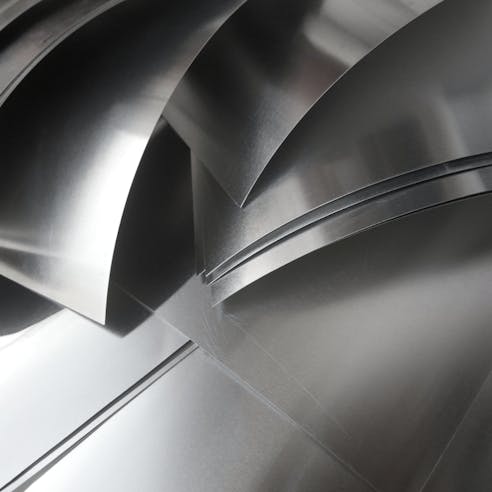
Lower Melting Point
Aluminum melts at 660 °C — far cooler than most engineering metals. It’s also difficult to weld since it has a tendency to burn before melting. Moreover, its low melting temperature means aluminum becomes softer and has reduced mechanical strength once temperatures exceed 200-250 °C. Combined, these facts make aluminum unsuitable for high-temperature operations.
Susceptibility to Galvanic Corrosion
Although aluminum resists most ordinary corrosive effects, it is susceptible to galvanic corrosion. When two dissimilar metals are in indirect or direct contact via an electrolytic fluid, galvanic corrosion occurs. The electrolyte facilitates the transfer of electrons between dissimilar metals. Aluminum will lose electrons to a more noble metal and thus will corrode. Aluminum is one of the least noble metals in the galvanic series table that describes the nobility of different metals. As such, it is highly susceptible to galvanic corrosion. To reduce the likelihood of galvanic corrosion in aluminum parts, place it only near metals that occupy similar positions on the galvanic scale.
Higher Cost Than Other Metals
Aluminum is more expensive than some other metals. Its cost can be attributed to the expensive and lengthy process of refining pure aluminum from bauxite and other aluminum-rich ores for the creation of different alloys. These processes are more energy-intensive than those used to extract other pure metals and use them for alloys. Aluminum’s relatively high price is why many companies opt to use Xometry for their aluminum fabrication needs.
In need of custom aluminum fabricated parts?
Applications in Industries Served by Aluminum Fabrication
Aluminum’s versatility, low mass, durability, strength-to-weight ratio, corrosion resistance, recyclability, and many other properties make it great for many industries. Listed below are a few of the most notable ones.
- Construction
- Aerospace
- Automotive
- Marine
- Electronics
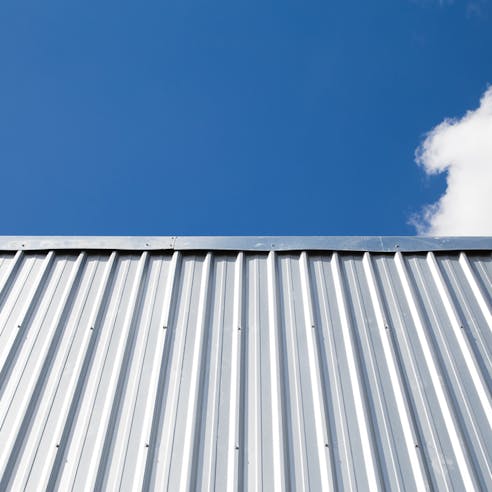
Construction
Buildings and infrastructure projects often involve aluminum in the form of external facades, walls, roofs, staircases, railings, shelves, and more. The metal is valued for its minimal mass and high strength-to-weight ratio. Additionally, aluminum’s durability and acceptance of lacquer or other finishes make it great for construction applications.
Aerospace
Many different aluminum alloys make their way into aerospace applications. 2024 aluminum alloy sheets, for example, get turned into fuselage and wing components while 2014 aluminum alloy is often used in interior framing components. Low density, high strength-to-weight ratio, durability, and natural corrosion resistance are the primary driving factors in the industry’s material selection. Aluminum fabrication techniques like CNC machining, die casting, forming, and laser cutting are all used to produce high-quality aerospace components.
Automotive
Aluminum is often used in automotive settings for its minimal weight, high strength-to-weight ratio, and natural corrosion resistance. Its low mass improves the efficiency of automobiles, while its high strength and corrosion resistance makes it great for load-bearing applications in outdoor environments. CNC machining, die casting, forming, and laser cutting are all common aluminum fabrication methods for automotive parts. From engine blocks and transmissions to brake components, frames, and electrical parts, aluminum is very common in the automotive industry.
Marine
The marine industry is another that commonly utilizes aluminum alloys. Aluminum silicon and aluminum-magnesium alloys are two of the most common alloys in marine products. They are valued for their corrosion resistance, strength, and low density. Corrosion resistance can be further improved by processes like anodizing or painting — important because salt water can accelerate galvanic effects. Aluminum is commonly employed in ladders, railings, and ship hulls.
Electronics
Aluminum has great electrical and thermal conductivity. These properties, as well as the low density, make aluminum great for electronics. From automotive and aerospace subsystems to consumer electronics, aluminum is used in numerous different electronic applications. Aluminum is often used for electrical wiring and electrical components like capacitors, antennas, heat sinks, and more.
Finishes
Xometry’s aluminum for sheet metal fabrication can be finished in a number of different ways. Some of the available options are listed below.
Anodizing: Anodizing is one of the more popular surface finishes available for sheet metal aluminum parts. Choose between normal and hard-coat anodizing. These surface finishes improve the aesthetics of the part while also enhancing its wear resistance.
Metal plating: Aluminum can be plated with a wide range of metals to increase its corrosion resistance, increase wear resistance, or improve overall aesthetics. Both electroplating and electroless plating are possible. Some common metals include tin, nickel, electroless nickel, gold, and silver. Learn more about the benefits of each type of coating.
Powder coating: Powder coating is a robust option for coloring aluminum sheet metal parts while also adding a measure of corrosion resistance.
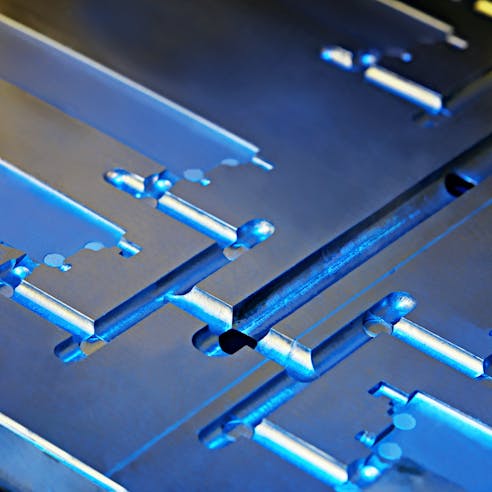
Cost-saving Design Tips
To reduce when designing parts with sheet metal aluminum alloys, try these cost-saving design tips:
DFM: Follow design-for-manufacturing principles like avoiding the addition of machined features to the part which will require additional operations that negate sheet metal’s cost-effectiveness. Review the Xometry sheet metal design guide to learn how to achieve all the functionality you need using common sheet metal fabrication techniques.
Choose the right alloy: As mentioned previously, some sheet metal alloys are better suited to bending than others. While it is possible to bend high-strength alloys, the necessary pre- and post-processing can often drive up costs.
Alternatives to Aluminum Fabrication
Despite its many advantages, aluminum may not be suitable when biocompatibility or significant strength is necessary. Below are two viable alternatives to aluminum fabrication.
- Steel Fabrication
- Titanium Fabrication

Steel Fabrication
Steel and aluminum often get compared head-to-head. Steel is better when exposed to extreme loads or high temperatures. Additionally, you may prefer steel if there’s little risk of corrosion or when you simply need cheap metal. Steel has higher yield strengths (220-1570 MPa) compared to aluminum (24-483 MPa). Steel also has a higher melting temperature (1,205-1,370 °C) than aluminum (660 °C). Moreover, basic steel is cheaper than aluminum. However, steel is much heavier than aluminum and is almost three times as dense. For applications that require high strength but where low weight and corrosion resistance aren’t major factors, steel is often preferred.
Titanium Fabrication
Titanium is another viable alternative to fabricated aluminum parts. Titanium has a density of 4.506 g/cm3 — denser than aluminum, but still minimal compared to most metals. Additionally, titanium has a high strength-to-weight ratio and a yield strength of 170-480 MPa, depending on the alloy. While it is slightly heavier and weaker than aluminum, titanium is harder and has a higher melting point (1649-1671 °C). This means titanium can be used in highly abrasive environments. Additionally, its higher melting point and temperature tolerance mean titanium’s properties won’t begin to change until it hits much higher temperatures than aluminum could dream of. Moreover, titanium is biocompatible, so it can be used in medical applications like implants and pacemakers. It’s not a perfect replacement, though; titanium is significantly more expensive than aluminum to process and alloy. Compared to aluminum, titanium is preferred for applications that require higher strength, abrasion resistance, or biocompatibility.
Why Use Xometry's Aluminum Fabrication Services?

Endless Options
Choose from millions of possible combinations of materials, finishes, tolerances, markings, and certifications for your order.

Easy to Use
Get your parts delivered right to your door without the hassle of sourcing, project management, logistics, or shipping.

Vetted Network
We are ISO 9001:2015, ISO 13485, and AS9100D certified. Only the top shops that apply to become Suppliers make it through our qualification process.
